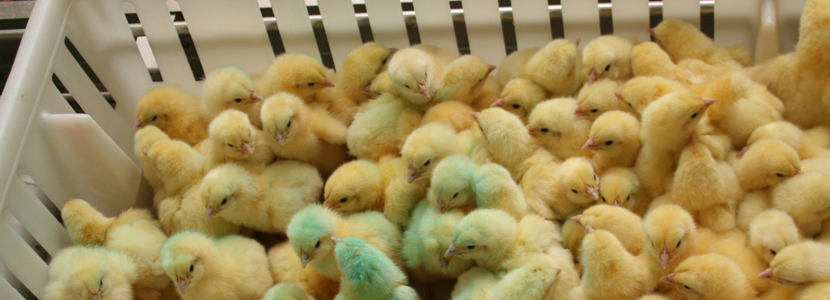Content available at: Español (Spanish)
Most commercially hatched chicks are vaccinated against multiple pathogens, including Newcastle virus, infectious bronchitis, coccidia, and others.
A very common method of administering vaccines in the hatchery is by spraying in booths or cabinets used for mass vaccination. The technology used varies between hatcheries and also depends on each manufacturer; for example, it can be a very simple and semi-manual tool, or a complicated and fully automated one. All modern spray booths have several components in common:
- A vaccine reservoir
- A sprinkler mechanism
- Spray nozzles for producing vaccine aerosols
- Other components that are essential for its operation
Most of the spray mechanisms consist of a system that uses sterile, single-use disposable plastic syringes that are used to load the vaccine from the reservoir and direct it through the spray nozzles to the chicks.
The syringes are normally operated by a compressed air system and are activated as the chick boxes travel through the cabins by actuating buttons or sensors that activate the system to vaccinate each box of chicks.
The nozzles of the sprinklers aerosolize the vaccines to produce a coarse spray that is responsible for directly coating the chicks.
This process is repeated thousands of times per day, and the goal is to efficiently apply a single dose of vaccine to each and every chick that passes through the system.
In these standardized spray systems, there are five main factors that influence the efficiency of vaccine application:
- The speed of the process
- Application volume
- The number and type of spray nozzles
- The flow of fluids through the nozzles
- Application pressure
PROCESS SPEED
The first variable that affects the efficiency of the vaccine application is the speed of the process. In smaller scale or less automated systems, vaccination by a spray cabinet can be carried out semi-manually. In this scenario, one person physically places the chick box inside the cabin to activate the sprinkler mechanism, so that the production speed does not impact the process at all.
Since the speed of the process in a hatchery does not change, the rest of the parameters must be adjusted to be compatible with the system and with the required speeds.
However, the production requirements of modern large-scale hatcheries call for extremely fast flows, operating at speeds up to 120 feet per minute.
The speed with which the chicks move through the spray booths is critical and must be kept at a rate that can ensure the correct and complete application of the number of doses from the syringe to the spray nozzles and eventually to the chicks.
If the chick boxes are moved too quickly, insufficient amount of vaccine will be given in the time available. If the chicks move too slowly, the vaccine could be given too quickly and not properly coat all the chicks.
Keep up to date with our newsletters
Receive the magazine for free in digital version
REGISTRATION
ACCESS
YOUR ACCOUNT
LOGIN
Lost your password?

